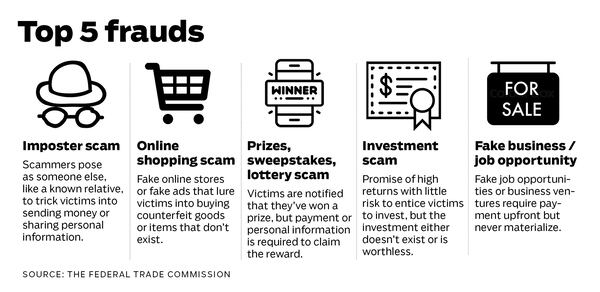Step away from that phone.
It is, of course, Americans’ principal device for sending messages, scrolling social media, checking on headlines, reading emails and even — occasionally — making a call to talk with someone. And since Americans increasingly prefer text to, you know, actually using the phone for talking to another person, it’s no surprise that texting is catching on with scamsters.
Social media is the most common forum for scams, according to Forbes magazine, followed by emails. Phone calls used to be the most common but as of 2022, they’ve fallen behind texts.
Texts account for more than 22% of all fraud reports, according to USAFacts, an online company that churns through government data and publishes what it finds interesting.
Scammers go where their targets are, said cyber-security expert Jon Powell, a partner at Moore Colson, an Atlanta-based accounting and consulting firm.
New technology like artificial intelligence improves the chances that scammers can reach you and fool you, he said.
“Users — you and I — are still the weakest link,” he said, “And (artificial intelligence) and AI tools have upped the game exponentially.”
Georgia had the highest rate of fraud reports of all types, not just texting, with 1,611 reports per 100,000 people, according to federal data from 2022 compiled by USAFacts.
To avoid being scammed, Powell advises starting with a healthy skepticism and, if you think there’s any chance it’s legitimate, trying to reach the person another way.
“All of a sudden your boss is texting you from a number you don’t know,” he said. “So, I would call him on his office phone. You never get in trouble for going back to make sure.”
Scammers also follow current events, Forbes said.
With the increase in weather disasters, scamsters increasingly offer schemes linked to FEMA. With President Joe Biden’s forgiveness of many student loans, those programs are used as a come-on.
“Make no mistake,” Forbes writes. “Scammers are always looking to exploit headlines by spinning up new ways to take advantage of consumers and the challenges we experience in our everyday lives. When we’re at our weakest and most hopeless, scammers see boundless opportunity.”
Verizon calls it “smishing,” a play on the previous wave of email scams called “phishing.” (Texting was originally called a “short message service,” or SMS.)
The phone company warns customers against clicking on uncertain links or providing personal details like banking and credit card information or Social Security numbers.
“Scam types vary, but they will all attempt to rope you in with lucrative offers (like free prize money from a reputed retailer); attempt to get you to divulge information or take action (by pretending to be a friend or family member in need); or dangle fake information about a transaction or account (like a package delivery),” Verizon says.
USAFacts was founded by Steve Ballmer, former Microsoft chief executive, who said he started the company in his post-corporate life. He was frustrated in the search for accurate and actionable information and got curious about what useful and fascinating tidbits the many arms of the U.S. government were collecting.
It recently turned up data from the Federal Trade Commission that showed the agency receiving 2.56 million fraud reports, including the text versions, with nearly a quarter of them involving money loss. One in five involved a loss of more than $5,000. About 125,000 were losses of less than $100, but 88,000 reports involved losses of more than $10,000.
Credit: ArLuther Lee
Credit: ArLuther Lee
According to the FTC data, Americans lost nearly $330 million through text message scams in 2022.
That is a fraction of the total lost to fraud, they say. Americans lost nearly $9 billion to fraud in 2022, but from the scammers’ point of view, texting seems to be the way to go, say the folks at USAFacts. “Text message scams are particularly effective.”
According to their calculations, the median amount of money lost in consumer fraud scams in 2022 was $650. And just a fraction — about 6% — of text scams lead to a loss of money but when they do, oh boy. The median loss in a text message scam was a cool $1,000.
The most common deceit seemed to be what the government called “business imposters.” More than 40% of the people who reported a text scam said the text claimed to be about a bank, gift, delivery, job, or online shopping.
Victims lost $35 million in those kinds of deceits. People lost $33.7 million in romance scams (“Oh darling, I am stuck in the Vienna airport on my way to our wedding, but I’ve been robbed and need some cash…”)
But the most costly scams on average were investment scams — haven’t you been looking for a can’t-miss tip on a stock tip? Or a real estate bargain that you must act on immediately since the news will leak in moments?
Investment scams are less common, but nearly $150 million was lost to those schemes, the FTC said.
Are we more gullible or are we just more likely to complain about it?
About the Author







